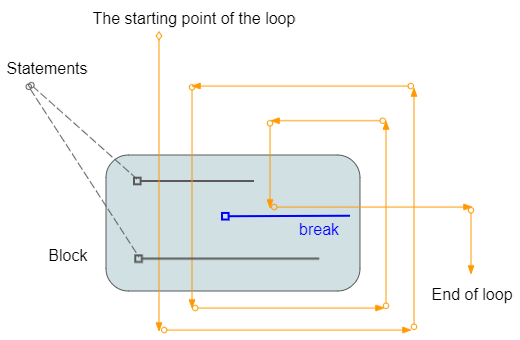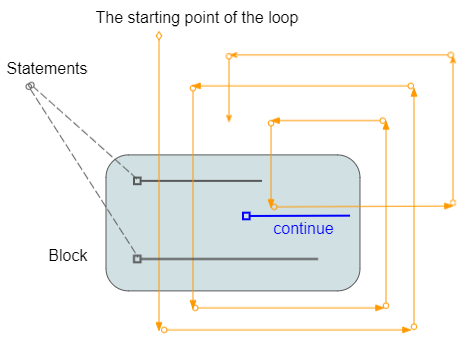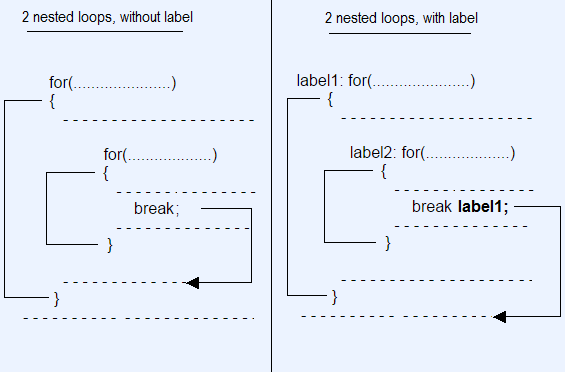Loops in Java
1. Loops in Java
In computer programming, a loop is used regularly, and the purpose is to execute a program snippet several times. The Java supports 3 different kinds of loops:
- for loop
- while loop
- do-while loop
The for loop has 2 variants:
- Common for loop.
- For-each loop (Introduced from Java 5 version ).
Statements can be used in a loop:
- break
- continue.
2. for Loop
Syntax:
** for **
// start_value: Start Value
// end_value: End Value
// increment_number: Added value after each iteration.
for ( start_value; end_value; increment_number ) {
// Do something here
}Consider an illustration:
ForLoopExample1.java
package org.o7planning.tutorial.javabasic.loop;
public class ForLoopExample1 {
public static void main(String[] args) {
// Declare a variable 'step', step in loop
int step = 1;
// Declare a variable value with the start value is 0
// After each iteration, value will increase 3
// And the loop will end when the value greater than or equal to 10
for (int value = 0; value < 10; value = value + 3) {
System.out.println("Step =" + step + " value = " + value);
// Increase 1
step = step + 1;
}
}
}Results of running the ForLoopExample1 class:
Step =1 value = 0
Step =2 value = 3
Step =3 value = 6
Step =4 value = 9See another example, sum the numbers from 1 to 100:
ForLoopExample2.java
package org.o7planning.tutorial.javabasic.loop;
public class ForLoopExample2 {
// This is an example to sum the numbers from 1 to 100,
// and print out the results to the console.
public static void main(String[] args) {
// Declare a variable
int total = 0;
// Declare a variable value
// Initial value is 1
// After each iteration increases the 'value' by adding 1
// Note: value++ equivalent to the statement: value = value + 1;
// value-- equivalent to the statement: value = value - 1;
for (int value = 1; value <= 100; value++) {
// Increase 'total' by adding 'value'.
total = total + value;
}
System.out.println("Total = " + total);
}
}Result:
Total = 50503. for-each loop
The for-each loop is introduced into Java from version 5. As a loop used to traverse an array or a collection, it will move from the first element to the last element of the array or collection respectively.
See more:
Syntax:
// arrayOrCollection: Array or Collection
for (Type variable: arrayOrCollection) {
// Code ...
}Example:
ForeachExample.java
package org.o7planning.tutorial.javabasic.loop;
public class ForeachExample {
public static void main(String[] args) {
// Declare an array of String.
String[] fruits = new String[] { "Apple", "Apricot", "Banana" };
// The for-each loop to traverse array.
for (String fruit : fruits) {
System.out.println(fruit);
}
}
}Run the example:
Apple
Apricot
Banana4. while Loop
The while loop is used to execute a program snippet repeatedly, when a condition is still true. The while loop is usually used when iterationsare not defined before (not fixed).
This is while loop structure:
** while **
// While condition is true then do something.
while ( condition ) {
// Do something here...
}See illustration
WhileExample1.java
package org.o7planning.tutorial.javabasic.loop;
public class WhileExampe1 {
public static void main(String[] args) {
int value = 3;
// While the 'value' is still less than 10, the loop still works.
while (value < 10) {
System.out.println("Value = " + value);
// Increase 'value' by adding 2
value = value + 2;
}
}
}5. do-while Loop
The do-while loop is used to execute a section of program many times.The characteristics of the do-while is that the block of statement is always executed at least once. After each iteration, the program will check the condition, if the condition is still correct, the statement block will be executed again.
This is the structure do-while loop:
** do while **
// The do-while loop performs at least one iteration.
// And while the condition is true, it continues to work
do {
// Do something here.
}
while (condition);Example:
DoWhileExample1.java
package org.o7planning.tutorial.javabasic.loop;
public class DoWhileExample1 {
public static void main(String[] args) {
int value = 3;
// do-while loop will execute at least once
do {
System.out.println("Value = " + value);
// Increase by 3
value = value + 3;
} while (value < 10);
}
}Result:
Value = 3
Value = 6
Value = 96. The break statement in loop
The break statement can appear in a loop. It is the statement that help the program exit the loop

Example:
LoopBreakExample.java
package org.o7planning.tutorial.javabasic.loop;
public class LoopBreakExample {
public static void main(String[] args) {
System.out.println("Break example");
int x = 2;
while (x < 15) {
System.out.println("----------------------\n");
System.out.println("x = " + x);
// If x = 5 then exit the loop.
if (x == 5) {
break;
}
x++;
System.out.println("x after ++ = " + x);
}
System.out.println("Done!");
}
}Running the example:
Break example
----------------------
x = 2
x after ++ = 3
----------------------
x = 3
x after ++ = 4
----------------------
x = 4
x after ++ = 5
----------------------
x = 5
Done!7. The continue statement in a loop
The continue statement can appear in a loop. When encountering the continue statement, the program will ignore the statement lines within the block and at the bottom of the continueand start an new iteration (If the condition is still correct).

Example:
LoopContinueExample.java
package org.o7planning.tutorial.javabasic.loop;
public class LoopContinueExample {
public static void main(String[] args) {
System.out.println("Continue example");
int x = 2;
while (x < 7) {
System.out.println("----------------------\n");
System.out.println("x = " + x);
// x = x + 1;
x++;
// % operator is used for calculating remainder.
// If x is even, then ignore the command line below of 'continue',
// and start new iteration (if condition still true).
if (x % 2 == 0) {
continue;
}
System.out.println("x after ++ = " + x);
}
System.out.println("Done!");
}
}Run the example:
Continue example
----------------------
x = 2
x after ++ = 3
----------------------
x = 3
----------------------
x = 4
x after ++ = 5
----------------------
x = 5
----------------------
x = 6
x after ++ = 7
Done!8. Labelled Loop
The Java allows you to stick a label to a loop. It is like you name a loop, which is useful when you use multiple nested loops in a program.
- You can use break labelX statement;to break a loop is attached labelX.
- You can use continue labelX statement; to continue a loop is attached labelX.

Syntax:
** Labelled Loops **
// for loop with Label.
label1: for( ... ) {
}
// while loop with Label.
label2: while ( ... ) {
}
// do-while loop with Label.
label3: do {
} while ( ... );Example of using nested loops, labelled and labelled break statement.
LabelledLoopBreakExample.java
package org.o7planning.tutorial.javabasic.loop;
public class LabelledLoopBreakExample {
public static void main(String[] args) {
System.out.println("Labelled Loop Break example");
int i = 0;
label1: while (i < 5) {
System.out.println("----------------------\n");
System.out.println("i = " + i);
i++;
label2: for (int j = 0; j < 3; j++) {
System.out.println(" --> " + j);
if (j > 0) {
// Exit the loop with label1.
break label1;
}
}
}
System.out.println("Done!");
}
}Run the example:
Labelled Loop Break example
----------------------
i = 0
--> 0
--> 1
Done!Example of using nested labelled loops and labelled continue statement.
LabelledLoopContinueExample.java
package org.o7planning.tutorial.javabasic.loop;
public class LabelledLoopContinueExample {
public static void main(String[] args) {
System.out.println("Labelled Loop Continue example");
int i = 0;
label1: while (i < 5) {
System.out.println("outer i= " + i);
i++;
label2: for (int j = 0; j < 3; j++) {
if (j > 0) {
continue label2;
}
if (i > 1) {
continue label1;
}
System.out.println("inner i= " + i + ", j= " + j);
}
}
}
}Run the example:
Labelled Loop Continue example
outer i= 0
inner i= 1, j= 0
outer i= 1
outer i= 2
outer i= 3
outer i= 4Java Basic
- Customize java compiler processing your Annotation (Annotation Processing Tool)
- Java Programming for team using Eclipse and SVN
- Java WeakReference Tutorial with Examples
- Java PhantomReference Tutorial with Examples
- Java Compression and Decompression Tutorial with Examples
- Configuring Eclipse to use the JDK instead of JRE
- Java String.format() and printf() methods
- Syntax and new features in Java 8
- Java Regular Expressions Tutorial with Examples
- Java Multithreading Programming Tutorial with Examples
- JDBC Driver Libraries for different types of database in Java
- Java JDBC Tutorial with Examples
- Get the values of the columns automatically increment when Insert a record using JDBC
- Java Stream Tutorial with Examples
- Java Functional Interface Tutorial with Examples
- Introduction to the Raspberry Pi
- Java Predicate Tutorial with Examples
- Abstract class and Interface in Java
- Access modifiers in Java
- Java Enums Tutorial with Examples
- Java Annotations Tutorial with Examples
- Comparing and Sorting in Java
- Java String, StringBuffer and StringBuilder Tutorial with Examples
- Java Exception Handling Tutorial with Examples
- Java Generics Tutorial with Examples
- Manipulating files and directories in Java
- Java BiPredicate Tutorial with Examples
- Java Consumer Tutorial with Examples
- Java BiConsumer Tutorial with Examples
- What is needed to get started with Java?
- History of Java and the difference between Oracle JDK and OpenJDK
- Install Java on Windows
- Install Java on Ubuntu
- Install OpenJDK on Ubuntu
- Install Eclipse
- Install Eclipse on Ubuntu
- Quick Learning Java for beginners
- History of bits and bytes in computer science
- Data Types in java
- Bitwise Operations
- if else statement in java
- Switch Statement in Java
- Loops in Java
- Arrays in Java
- JDK Javadoc in CHM format
- Inheritance and polymorphism in Java
- Java Function Tutorial with Examples
- Java BiFunction Tutorial with Examples
- Example of Java encoding and decoding using Apache Base64
- Java Reflection Tutorial with Examples
- Java remote method invocation - Java RMI Tutorial with Examples
- Java Socket Programming Tutorial with Examples
- Which Platform Should You Choose for Developing Java Desktop Applications?
- Java Commons IO Tutorial with Examples
- Java Commons Email Tutorial with Examples
- Java Commons Logging Tutorial with Examples
- Understanding Java System.identityHashCode, Object.hashCode and Object.equals
- Java SoftReference Tutorial with Examples
- Java Supplier Tutorial with Examples
- Java Aspect Oriented Programming with AspectJ (AOP)
Show More
- Java Servlet/Jsp Tutorials
- Java Collections Framework Tutorials
- Java API for HTML & XML
- Java IO Tutorials
- Java Date Time Tutorials
- Spring Boot Tutorials
- Maven Tutorials
- Gradle Tutorials
- Java Web Services Tutorials
- Java SWT Tutorials
- JavaFX Tutorials
- Java Oracle ADF Tutorials
- Struts2 Framework Tutorials
- Spring Cloud Tutorials